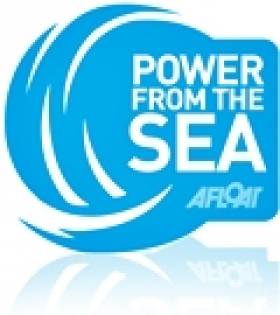Displaying items by tag: ScottishPower Renewables
£50m Offshore Wind Terminal Completed in Belfast Harbour
#BelfastWindTerminal - A new £50m offshore wind terminal which has been completed in Belfast Harbour, has been handed over to DONG Energy and ScottishPower Renewables.
As previously reported on Afloat.ie, the terminal, the first purpose-built offshore wind installation and pre-assembly harbour in the UK or Ireland, will be used as a hub to help service a market valued in excess of 100bn. Up to 300 jobs are expected to be created, ranging from welders to electricians and engineers.
The official hand-over was attended by Northern Ireland's First and Deputy First Ministers, Peter Robinson MLA and Martin McGuinness MLA, along with Len O Hagan, Belfast Harbour's Chairman and Brent Cheshire, DONG Energys UK Country Chairman.
DONG Energy has signed a lease for the terminal which will be used initially to support the development of the West of Duddon Sands Wind farm in the Irish Sea, a joint venture between ScottishPower Renewables and DONG Energy. Work on the wind farm has already started and Belfast Harbour has received its first shipment of wind farm components. Its anticipated that the first turbines will depart Belfast this summer for erection at the site.
Welcoming the handover, Len OHagan, Belfast Harbour's Chairman, said: "Delivering this immense project on time and on budget has been a major achievement. This is a historic development for Belfast which has the potential to usher in a major new industry for Northern Ireland a development which is all the more poignant given that this is the Harbours 400th anniversary year".
He added "Over the years the harbour has helped bring other industries to Belfast such as shipbuilding and aerospace by investing heavily in infrastructure and land reclamation. This is a continuation of that strategy and a demonstration of our long-term commitment to enhance the local economy".
The 50-acre terminal, located on the Co. Down side of the port, is the largest single investment in Belfast Harbours 400-year history. Built by local construction company Farrans, the project took 15-months, 750,000 man hours, one million tonnes of stones and 30,000 tonnes of concrete to complete.
The 200,000 m2 facility, large enough to accommodate 30 football pitches, includes a 480m deep-water quayside. Up to three vessels will be able to berth simultaneously with access available around the clock.
Brent Cheshire, DONG Energys UK Country Chairman commented: "Having a bespoke facility at our fingertips will help us plan our offshore construction very effectively and help with our work to lower the cost of offshore wind farms. The site is in an excellent strategic position for DONG Energy as we have several wind farms under development in the Irish Sea. This is a port that can handle the large number of huge pieces of equipment required".
Keith Anderson, ScottishPower Renewables CEO, added: "The facility at Belfast Harbour is one of the most advanced anywhere in the world for the assembly of offshore wind turbines, and we are delighted to be taking over the lease as we start offshore construction on the West of Duddon Sands project.
This marks a significant milestone for the West of Duddon Sands project, and we are sure that Belfast will play a hugely important role in its successful delivery. The investment in Belfast Harbour will ensure that the city has a long-term future as a leader in renewable energy.
Over 100 turbines, each with a rotor diameter of 120m, will be shipped from the new terminal to the West of Duddon Sands project. It will be one of the worlds largest offshore wind farms when it is commissioned in 2014.
The UK is Europes leading offshore wind generator and has plans to develop 11,000 new offshore wind turbines, a quarter of which are expected to be built within 150 nautical miles of Belfast. It is anticipated that 32 gigawatts of electricity, one quarter of the nations electricity needs, will be provided by offshore wind.
Scotland To Host World's Biggest Tidal Power Array
Scotland's west coast will be home to the world's largest tidal power facility, it has been announced.
The £40 million (€45.9 million) 10MW tidal array, to be developed by ScottishPower Renewables in the Sound of Islay, will generate power for more than 5,000 homes.
Scottish Cabinet Secretary for Finance John Swinney, who signed off on the deal, described the project as "a milestone in the global development of tidal energy".
"Scotland's seas have unrivalled potential to generate green energy, create new, low carbon jobs, and bring billions of pounds of investment to Scotland," he said.
The project comes in tandem with the consultation process for the Scottish government's National Marine Plan, intended to highlight the best opportunities for investment across all marine industries.
Energy & Environmental Management has more on the story HERE.

























































